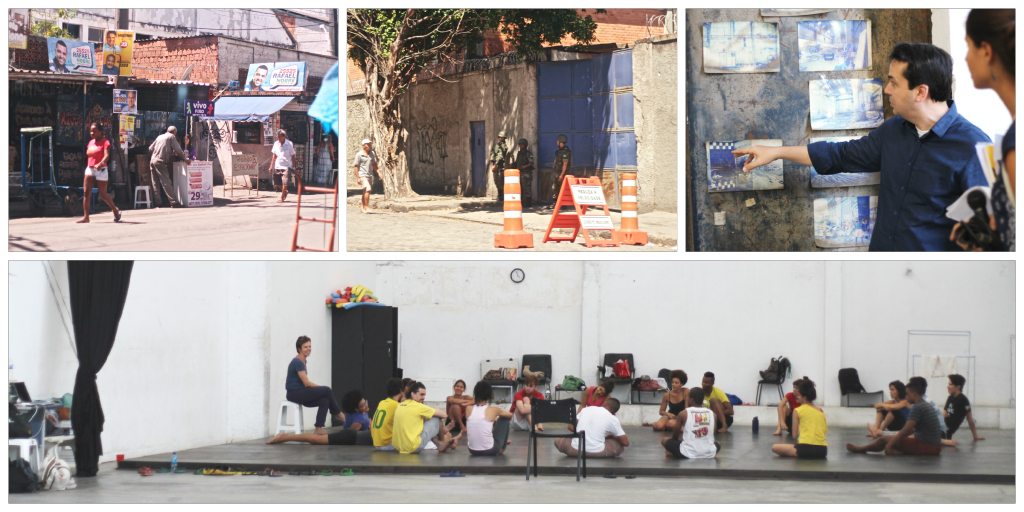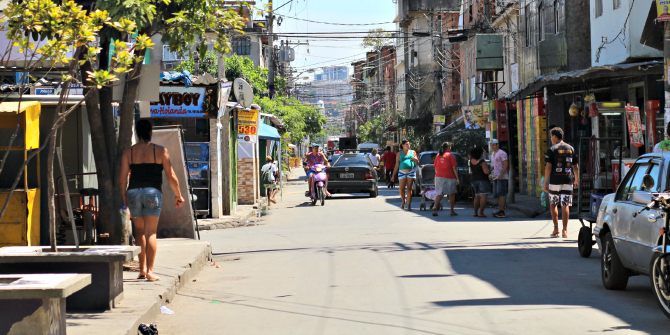 The resourcefulness and resilience that characterise homegrown movements in Brazilian favelas are increasingly documented and acknowledged. In this post, Zaneta Denny contributes to this discussion by presenting the initiatives of Redes de Desenvolvimento da Maré, a favela-based NGO. Despite the organisation’s manifold achievements, coupled with Brazil’s economic growth, there is still a lot to be done to increase the number and quality of opportunities for residents, she suggests.
The resourcefulness and resilience that characterise homegrown movements in Brazilian favelas are increasingly documented and acknowledged. In this post, Zaneta Denny contributes to this discussion by presenting the initiatives of Redes de Desenvolvimento da Maré, a favela-based NGO. Despite the organisation’s manifold achievements, coupled with Brazil’s economic growth, there is still a lot to be done to increase the number and quality of opportunities for residents, she suggests.
Complexo da Maré, located near Rio’s international airport, is one of the city’s largest favelas. In this post, I discuss the determination of an NGO to provide dignity and opportunity to Maré residents living through urban warfare against the backdrop of years of government neglect.
Maré means “tide” in Portuguese. Edson Diniz, Maré native and one of the founders of the non-governmental organisation Redes de Desenvolvimento da Maré (Maré’s Development Networks) told me, “There is no way to enter and leave Rio without seeing the Maré. Maybe that’s why she appears so much and has been so remarkable in the imagination of Rio de Janeiro, for the good and the bad”.
In my case Maré figured badly. Nightmarish even. Ten days before my arrival in the Maré, Osmar Paiva Camelo, president of the residents association Associação de Moradores do Morro do Timbau, was assassinated at the organisation’s headquarters, just three days after the signing of a presidential decree that extended the stay of the police pacification units, the government’s anti-gang public security force. In Rio my colleague called the association to speak to a representative, only to hear the voice of his grieving wife on the other end: predictably, she did not want to be interviewed. The identity of Paiva’s murderers, as with many deaths of favela activists and residents, is officially unknown. Local gangs, a local militia, even government forces remain potential Machiavellian actors.
“The situation today is a nervous calm in a very tense peace”, Diniz avers. By the time my co-producer and I returned to our base at Facha University, a shooting had occurred. “Although the army is here, conflicts still happen between armed groups. They happen far less than when the army wasn’t here, but it’s not the ideal situation that the residents want”.
Diniz, a qualified teacher and lecturer in education, explains, “We need to have other investments in other areas”. He insists, “We actually have to have a greater presence of the state and higher investments, especially for the youth of Maré, who have major difficulties in getting a job, to study”.
The inequality is alarming:
“There are 130,000 residents and we only have two high schools”, Diniz explains, “So the boys who want to do high school have great difficulty. We have a large portion of Maré youth who neither work nor study…So without these investments, the presence of only the army or the police does not solve these issues. At some times it exacerbates these problems of violence”.
Against this backdrop, for more than 20 years Redes has struggled to transform the historical social reality of neglect in the Maré. Diniz explains that in the 1940s, homeless migrants searching for work in construction of Avenida Brasil highway began to build shacks without government support or approval. Under Projeto Rio the government destroyed the shacks, took residents away and put them in low cost council houses in the Maré. Neglect allowed drug gangs to assert their authority.
Most of the founders of Redes are teachers. So for their first project in 1992, now called Rede de Saberes (Networks of Knowledge), they offered free tuition for the Pré Vestibular, Brazil’s university entrance examination. “At the time we had 0.6% of people from Maré in the universities”, says Diniz. “It was not normal for people from the favela to go to university”. Redes has managed to send 900 students to university.
Redes offers over 30 different projects for youth and locals, from French classes to female health. When nine residents and police officers were slaughtered in 2013, Redes teamed up with Amnesty International to run a campaign informing residents on their rights.
Another initiative was the Censo da Maré (Maré Census), for which Redes decided to build on the Brazilian Institute of Geography and Statistics’ census work to conduct a detailed study on Maré’s entrepreneurial activity. “To achieve a socioeconomic level of development and cultural distinct than you have today, the performance in areas such as Maré requires a deeper knowledge of the peculiarities of the territory and the demands of its inhabitants”.
With Brazil’s economic growth, however, there are new challenges for NGOs. “Everywhere all the social movements and civil society organisations are having a very bad time. We used to have funds from other countries”, says Shirely Villela, a former Gender Response officer for the UN Women’s Agency, now instructor of Maré de Sabores a women’s food business class at Redes. However the UN measures the necessity and demands of a country by the Human Development Index: “Brazil has been improving on this”, Villela acknowledges, “but it doesn’t mean that in such a large country everybody is okay and we don’t need any more funds”.
The enduring needs of favela residents can be observed in the day-to-day practices of favela-based NGOs. Talking about the Mão na Lata (Hand in the Can) project, Redes co-director Patrícia Viana says: “All these photos were taken in places where the stories of Machado de Assis happened, places inside the Maré; they relate these stories to their reality”.
The eerie photos by young Maré residents do not bear any trace of the critical cynicism associated with Assis, known as “Brazil’s Charles Dickens” for the social justice themes which run through his work. Yet the can cameras act as guerrilla camouflage in a favela where cameras are viewed with suspicion. One cannot but wonder how little the bourgeois, secretly prejudiced city has changed?
“It may seem silly, but a large part of the population believes that Rio’s favela is não cidade (“not city”), that the favelados, the favela people are the enemy of the city”, Diniz details. “We try to deconstruct this concept”, Diniz is insistent; “we try to say that the favela is the city and actually builds the city”.
All images kindly provided by Zaneta Denny.
About the Author
Blogger at Creolita Culture (in development) writer and producer interested in hidden narratives from around the world, London-born, Zaneta is of Caribbean and Guyanese descent. She studied European Studies at King’s College London.
The views expressed on this post belong solely to the author and should not be taken as the opinion of the Favelas@LSE Blog nor of the LSE.
Please read our comments policy before commenting.







1 Comments